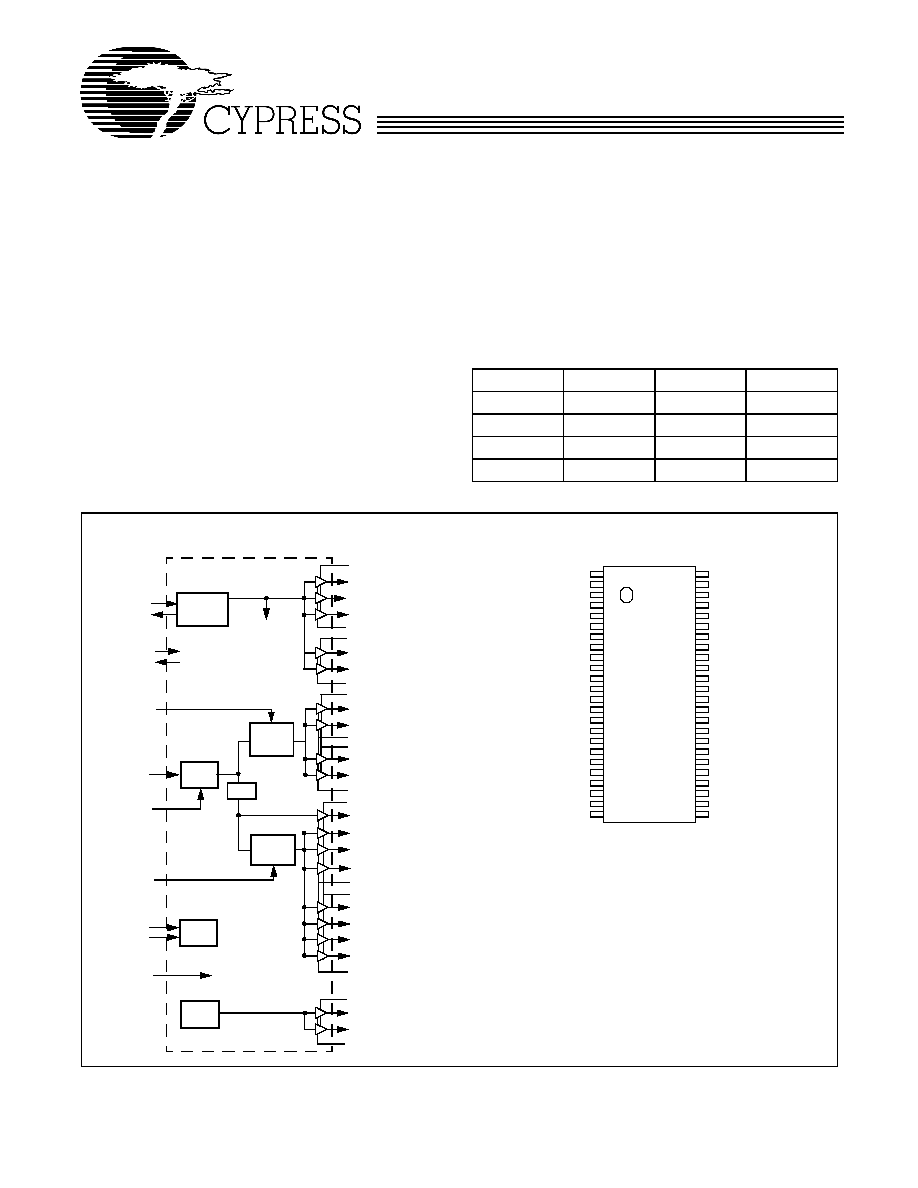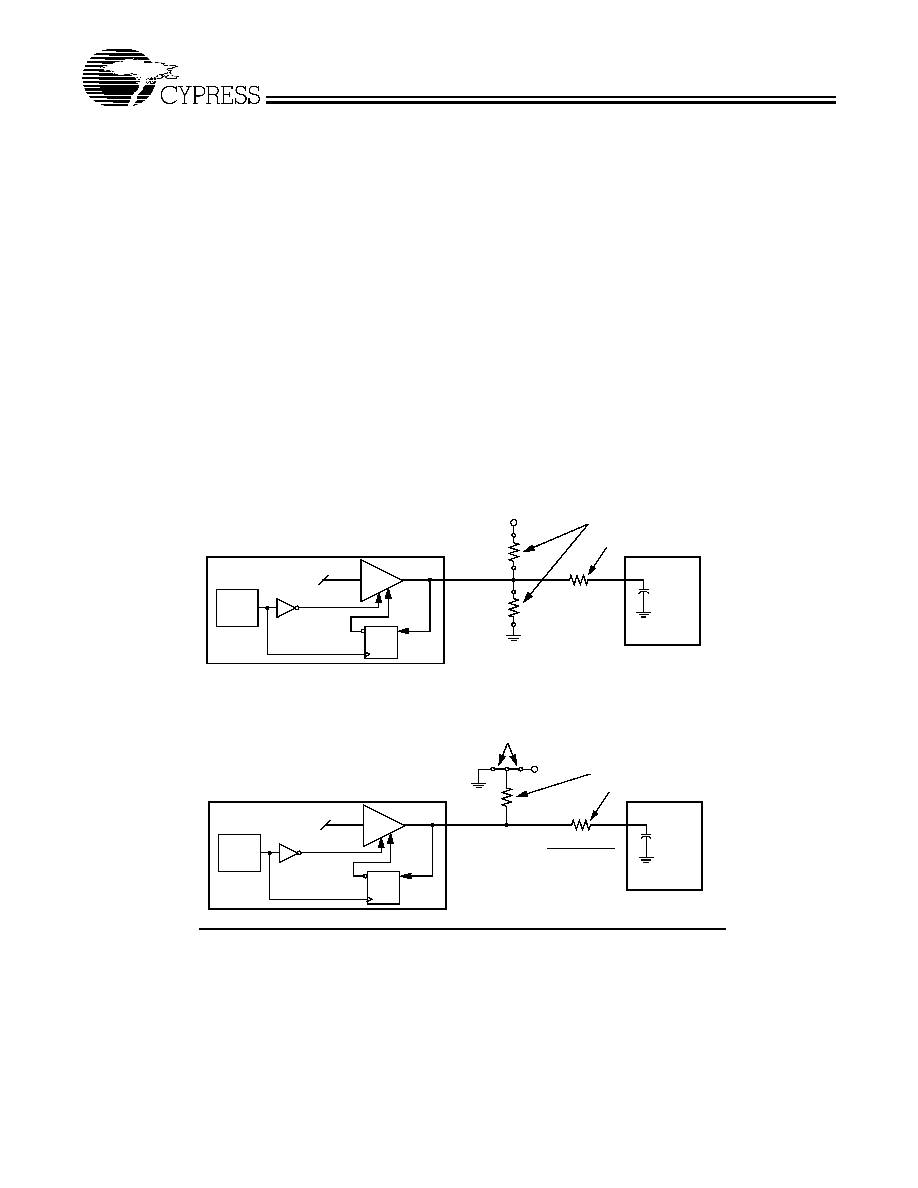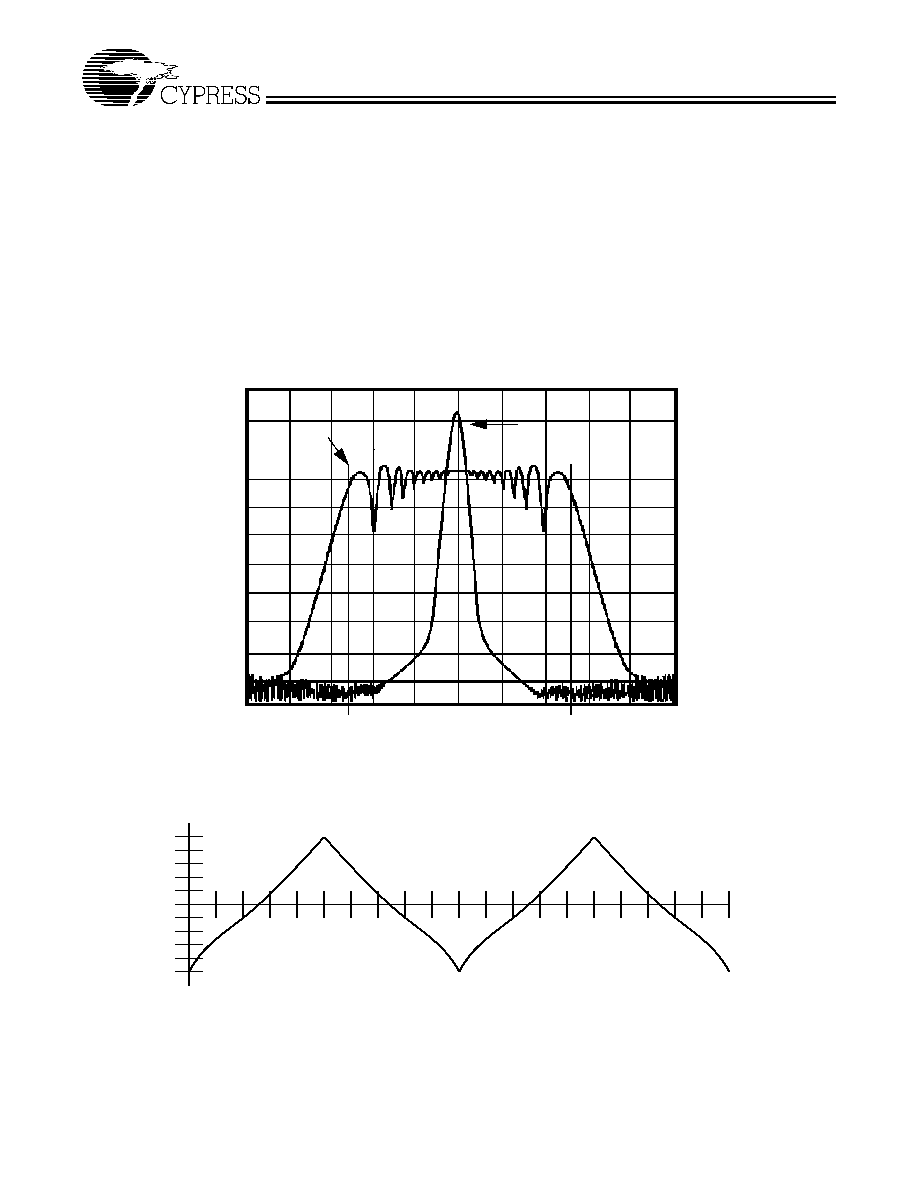 | –≠–ª–µ–∫—Ç—Ä–æ–Ω–Ω—ã–π –∫–æ–º–ø–æ–Ω–µ–Ω—Ç: W204H | –°–∫–∞—á–∞—Ç—å:  PDF PDF  ZIP ZIP |

Spread Spectrum FTG for 440BX and VIA Apollo Pro-133
W204
PRELIMINARY
Cypress Semiconductor Corporation
∑
3901 North First Street
∑
San Jose
∑
CA 95134
∑
408-943-2600
Document #: 38-07264 Rev. *A
Revised December 22, 2002
Features
∑ Maximized EMI suppression using Cypress's spread
spectrum technology
∑ Optimized system frequency synthesizer for 440BX and
VIA Apollo Pro-133
∑ Four copies of CPU output
∑ Eight copies of PCI clock (synchronous w/CPU output)
∑ Two copies of 14.318-MHz IOAPIC output and three
buffered copies of 14.318-MHz reference input
∑ One copy of 48-MHz USB output
∑ Selectable 24-/48-MHz clock-through-resistor
strapping
∑ Power management control input pins
∑ Programmable clock outputs up to 155 MHz via SMBus
interface (32 selectable frequencies)
Key Specifications
Supply Voltages: ..................................... VDDQ3 = 3.3V±5%
VDDQ2 = 2.5V±5%
CPU Cycle to Cycle Jitter: .......................................... 250 ps
CPU0:3 Output Skew: ................................................ 175 ps
PCI_F, PCI1:7 Output Skew: ....................................... 500 ps
CPU to PCI Output Skew: ............... 1.0≠4.0 ns (CPU Leads)
REF0/SEL48#, SCLK,SDATA:........................... 250K pull-up
FS1: ............................................................... 250K pull-down
FS0: ...................................................No pull-up or pull-down
Test mode and output three-state through SMBus interface
Table 1. Pin Selectable Frequency
FS1
FS0
CPU(0:3)
PCI
1
1
133.3 MHz
33.3 MHz
1
0
105 MHz
35 MHz
0
1
100 MHz
33.3 MHz
0
0
66.8 MHz
33.3 MHz
Pin Configuration
Block Diagram
VDDQ3
REF0/SEL48#
VDDQ2
APIC0
CPU0
CPU1
CPU2
CPU3
PCI_F
XTAL
PLL Ref Freq
PLL 1
FS0:1
X2
X1
REF1
VDDQ3
Stop
Clock
Control
Stop
Clock
Control
PCI1
PWR_DWN#
Power
Down
Control
PCI2
PCI3
PCI4
PCI5
48MHz
24_48MHz/FS1
PLL2
˜2/˜3
OSC
REF2
VDDQ2
PCI_STOP#
CPU_STOP#
PCI6
PCI7
GND
GND
VDDQ3
GND
APIC1
GND
GNDCORE0/1
VDDCORE0/1
VDDQ3
GND
GND
GND
VDDQ2
SPREAD#
I
2
C
SDATA
Logic
SCLK
REF0/SEL48#
REF1
GND
X1
X2
GND
PCI_F
PCI1
VDDQ3
PCI2
PCI3
GND
PCI4
PCI5
VDDQ3
PCI6
PCI7
GND
VDDQ3
GND
VDDQ3
48MHz
24_48MHz/FS1
GND
VDDQ3
REF2
VDDQ2
APIC0
APIC1
GND
NC
VDDQ2
CPU0
CPU1
GND
VDDQ2
CPU2
CPU3
GND
VDDQ3
GND
PCI_STOP#
CPU_STOP#
PWR_DWN#
SPREAD#
SDATA
SCLK
FS0
48
47
46
45
44
43
42
41
40
39
38
37
36
35
34
33
32
31
30
29
28
27
26
25
1
2
3
4
5
6
7
8
9
10
11
12
13
14
15
16
17
18
19
20
21
22
23
24
Note:
1.
Internal pull-up resistors should not be relied upon for setting I/O
pins HIGH.
[1]

W204
PRELIMINARY
Document #: 38-07264 Rev. *A
Page 2 of 16
Pin Definitions
Pin Name
Pin
No.
Pin
Type
Pin Description
CPU0:3
40, 39, 36,
35
O
CPU Clock Outputs 0 through 3: These four CPU clock outputs are controlled by
the CPU_STOP# control pin. Output voltage swing is controlled by voltage applied
to VDDQ2.
PCI1:7
8, 10, 11, 13,
14, 16, 17
O
PCI Bus Clock Outputs 1 through 7: These seven PCI clock outputs are controlled
by the PCI_STOP# control pin. Output voltage swing is controlled by voltage applied
to VDDQ3.
PCI_F
7
O
Fixed PCI Clock Output: Unlike PCI1:7 outputs, this output is not controlled by the
PCI_STOP# control pin. Output voltage swing is controlled by voltage applied to
VDDQ3.
CPU_STOP#
30
I
CPU_STOP# Input: When brought LOW, clock outputs CPU0:3 are stopped LOW
after completing a full clock cycle (2-3 CPU clock latency). When brought HIGH,
clock outputs CPU0:3 start beginning with a full clock cycle (2-3 CPU clock latency).
PCI_STOP#
31
I
PCI_STOP# Input: The PCI_STOP# input enables the PCI 1:7 outputs when HIGH
and causes them to remain at logic 0 when LOW. The PCI_STOP signal is latched
on the rising edge of PCI_F. Its effect takes place on the next PCI_F clock cycle.
SPREAD#
28
I
SPREAD# Input: When brought low this pin activates Spread Spectrum clocking.
APIC0:1
45, 44
O
I/O APIC Clock Outputs: Provides 14.318-MHz fixed frequency. The output voltage
swing is controlled by VDDQ2.
48MHz
22
O
48-MHz Output: Fixed clock outputs at 48 MHz. Output voltage swing is controlled
by voltage applied to VDDQ3.
24_48MHz/FS1
23
O
24-MHz or 48-MHz Output/Frequency Select 1: 24 MHz output when pin 1 is
strapped through 10-K
resistor to VDDQ3. 48-MHz output when pin 1 is strapped
through 10-K
resistor to GND. This pin also serves as the select strap to determine
device operating frequency as described in Table 1.
REF0/SEL48#
1
I/O
I/O Dual-Function REF0 and SEL48# pin: During power-on, SEL48# input will be
latched which will set pin 23 to output 24 MHz or 48 MHz. It then reverts to REF0
fixed output.
REF1:2
2, 47
O
Fixed 14.318-MHz Outputs 1 through 2: Used for various system applications.
Output voltage swing is controlled by voltage applied to VDDQ3.
FS0
25
I
Frequency Selection 0: Selects power-up default CPU clock frequency as shown
in Table 1.
SCLK
26
I
Clock pin for SMBus circuitry.
SDATA
27
I/O
Data pin for SMBus circuitry.
X1
4
I
Crystal Connection or External Reference Frequency Input: This pin has dual
functions. It can be used as an external 14.318-MHz crystal connection or as an
external reference frequency input.
X2
5
I
Crystal Connection: An input connection for an external 14.318-MHz crystal. If
using an external reference, this pin must be left unconnected.
PWR_DWN#
29
I
Power-Down Control: When this input is LOW, device goes into a low-power stand-
by condition. All outputs are actively held LOW while in power-down. CPU and PCI
clock outputs are stopped LOW after completing a full clock cycle (2≠3 CPU clock
cycle latency). When brought high, CPU, SDRAM and PCI outputs start with a full
clock cycle at full operating frequency (3 ms maximum latency).
VDDQ3
9, 15, 19, 21,
33, 48
P
Power Connection: Connect to 3.3V supply.
VDDQ2
46, 41, 37
P
Power Connection: Power supply for APIC0:1 and CPU0:3 output buffers. Connect
to 2.5V.
GND
3, 6, 12, 18,
20, 24, 32,
34, 38, 43
G
Ground Connections: Connect all ground pins to the common system ground
plane.

W204
PRELIMINARY
Document #: 38-07264 Rev. *A
Page 3 of 16
Overview
The W204, a motherboard clock synthesizer, can provide ei-
ther a 2.5V or 3.3V CPU clock swing making it suitable for a
variety of CPU options. A fixed 48-MHz clock is provided for
other system functions. The device W204 supports spread
spectrum clocking for reduced EMI.
Functional Description
I/O Pin Operation
Pins 1 and 23 are dual-purpose l/O pins. Upon power-up these
pins act as a logic input, allowing the determination of as-
signed device functions. A short time after power-up, the logic
state of the pin is latched and the pin becomes a clock output.
This feature reduces device pin count by combining clock out-
puts with input select pins.
An external 10-K
"strapping" resistor is connected between
the l/O pin and ground or V
DD
. Connection to ground sets a
latch to "0", connection to V
DD
sets a latch to "1". Figure 1 and
Figure 2 show two suggested methods for strapping resistor
connections.
Upon W204 power-up, the first 2 ms of operation is used for
input logic selection. During this period, pins 1 and 23 are
three-stated, allowing the output strapping resistor on the l/O
pin to pull the pin and its associated capacitive clock load to
either a logic HIGH or LOW state. At the end of the 2-ms peri-
od, the established logic "0" or "1" condition of the l/O pin is
then latched. Next the output buffer is enabled which converts
the l/O pin into an operating clock output. The 2-ms timer is
started when V
DD
reaches 2.0V. The input bits can only be
reset by turning V
DD
off and then back on again.
It should be noted that the strapping resistors have no signifi-
cant effect on clock output signal integrity. The drive imped-
ance of clock output is 40
(nominal) which is minimally affect-
ed by the 10-K
strap to ground or V
DD
. As with the series
termination resistor, the output strapping resistor should be
placed as close to the l/O pin as possible in order to keep the
interconnecting trace short. The trace from the resistor to
ground or V
DD
should be kept less than two inches in length
to prevent system noise coupling during input logic sampling.
When the clock outputs are enabled following the 2-ms input
period, the associated output frequencies are delivered on the
pins, assuming that V
DD
has stabilized. If V
DD
has not yet
reached full value, output frequency initially may be below tar-
get but will increase to target once V
DD
voltage has stabilized.
In either case, a short output clock cycle may be produced
from the CPU clock outputs when the outputs are enabled.
Power-on
Reset
Timer
Output Three-state
Data
Latch
Hold
Q
D
W204
V
DD
Clock Load
10 k
Output
Buffer
(Load Option 1)
10 k
(Load Option 0)
Output
Low
Output Strapping Resistor
Series Termination Resistor
Figure 1. Input Logic Selection Through Resistor Load Option
Power-on
Reset
Timer
Output Three-state
Data
Latch
Hold
Q
D
W204
V
DD
Clock Load
R
10 k
Output
Buffer
Output
Low
Output Strapping Resistor
Series Termination Resistor
Jumper Options
Resistor Value R
Figure 2. Input Logic Selection Through Jumper Option

W204
PRELIMINARY
Document #: 38-07264 Rev. *A
Page 4 of 16
Spread Spectrum Feature
The device generates a clock that is frequency modulated in
order to increase the bandwidth that it occupies. By increasing
the bandwidth of the fundamental and its harmonics, the am-
plitudes of the radiated electromagnetic emissions are re-
duced. This effect is depicted in Figure 3.
As shown in Figure 3, a harmonic of a modulated clock has a
much lower amplitude than that of an unmodulated signal. The
reduction in amplitude is dependent on the harmonic number
and the frequency deviation or spread. The equation for the
reduction is:
dB = 6.5 + 9*log
10
(P) + 9*log
10
(F)
Where P is the percentage of deviation and F is the frequency
in MHz where the reduction is measured.
The output clock is modulated with a waveform depicted in
Figure 4. This waveform, as discussed in "Spread Spectrum
Clock Generation for the Reduction of Radiated Emissions" by
Bush, Fessler, and Hardin produces the maximum reduction
in the amplitude of radiated electromagnetic emissions. The
deviation selected for this chip is ± 0.5% of the center frequen-
cy. Figure 4 details the Cypress spreading pattern. Cypress
does offer options with more spread and greater EMI reduc-
tion. Contact your local Sales representative for details on
these devices.
Figure 3. Clock Harmonic with and without SSCG Modulation Frequency Domain Representation
Figure 4. Typical Modulation Profile
SSFTG
Typical Clock
Frequency Span (MHz)
≠1.0
+1.0
0
≠0.5%
≠SS%
+SS%
Amplitud
e
(dB)
5dB/div
+0.5%
MAX (+0.5%)
MIN (≠0.5%)
10
%
20
%
30
%
40
%
50
%
60
%
70
%
80
%
90
%
10
0%
10
%
20
%
30
%
40
%
50
%
60
%
70
%
80
%
90
%
10
0%
FREQUENCY

W204
PRELIMINARY
Document #: 38-07264 Rev. *A
Page 5 of 16
Serial Data Interface
The W204 features a two-pin, serial data interface that can be
used to configure internal register settings that control partic-
ular device functions. Upon power-up, the W204 initializes with
default register settings. Therefore, the use of this serial data
interface is optional. The serial interface is write-only (to the
clock chip) and is the dedicated function of device pins SDATA
and SCLOCK. In motherboard applications, SDATA and
SCLOCK are typically driven by two logic outputs of the
chipset. Clock device register changes are normally made
upon system initialization, if required. The interface can also
be used during system operation for power management func-
tions. Table 2 summarizes the control functions of the serial
data interface.
Operation
Data is written to the W204 in ten bytes of eight bits each.
Bytes are written in the order shown in Table 3.
Table 2. Serial Data Interface Control Functions Summary
Control Function
Description
Common Application
Clock Output Disable
Any individual clock output(s) can be disabled.
Disabled outputs are actively held LOW.
Unused outputs are disabled to reduce EMI and
system power. Examples are clock outputs to un-
used PCI slots.
CPU Clock Frequency
Selection
Provides CPU/PCI frequency selections beyond
the 100- and 66.66-MHz selections that are pro-
vided by the FS0:1 pins. Frequency is changed in
a smooth and controlled fashion.
For alternate microprocessors and power man-
agement options. Smooth frequency transition al-
lows CPU frequency change under normal system
operation.
Output Three-state
Puts all clock outputs into a high impedance state. Production PCB testing.
Test Mode
All clock outputs toggle in relation to X1 input, in-
ternal PLL is bypassed. Refer to Table 4.
Production PCB testing.
(Reserved)
Reserved function for future device revision or pro-
duction device testing.
No user application. Register bit must be written
as 0.
Table 3. Byte Writing Sequence
Byte
Sequence
Byte Name
Bit Sequence
Byte Description
1
Slave Address
11010010
Commands the W204 to accept the bits in Data Bytes 3≠6 for internal
register configuration. Since other devices may exist on the same com-
mon serial data bus, it is necessary to have a specific slave address for
each potential receiver. The slave receiver address for the W204 is
11010010. Register setting will not be made if the Slave Address is not
correct (or is for an alternate slave receiver).
2
Command
Code
Don't Care
Unused by the W204, therefore bit values are ignored ("Don't Care"). This
byte must be included in the data write sequence to maintain proper byte
allocation. The Command Code Byte is part of the standard serial com-
munication protocol and may be used when writing to another addressed
slave receiver on the serial data bus.
3
Byte Count
Don't Care
Unused by the W204, therefore bit values are ignored ("Don't Care"). This
byte must be included in the data write sequence to maintain proper byte
allocation. The Byte Count Byte is part of the standard serial communi-
cation protocol and may be used when writing to another addressed slave
receiver on the serial data bus.
4
Data Byte 0
Don't Care
Refer to Cypress SDRAM drivers.
5
Data Byte 1
6
Data Byte 2
7
Data Byte 3
Refer to Table 4
The data bits in these bytes set internal W204 registers that control device
operation. The data bits are only accepted when the Address Byte bit
sequence is 11010010, as noted above. For description of bit control
functions, refer to Table 4, Data Byte Serial Configuration Map.
8
Data Byte 4
9
Data Byte 5
10
Data Byte 6




